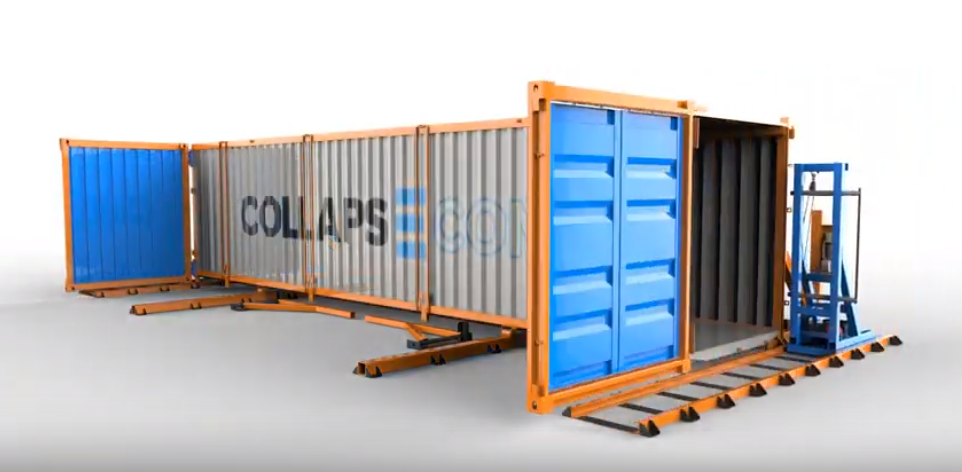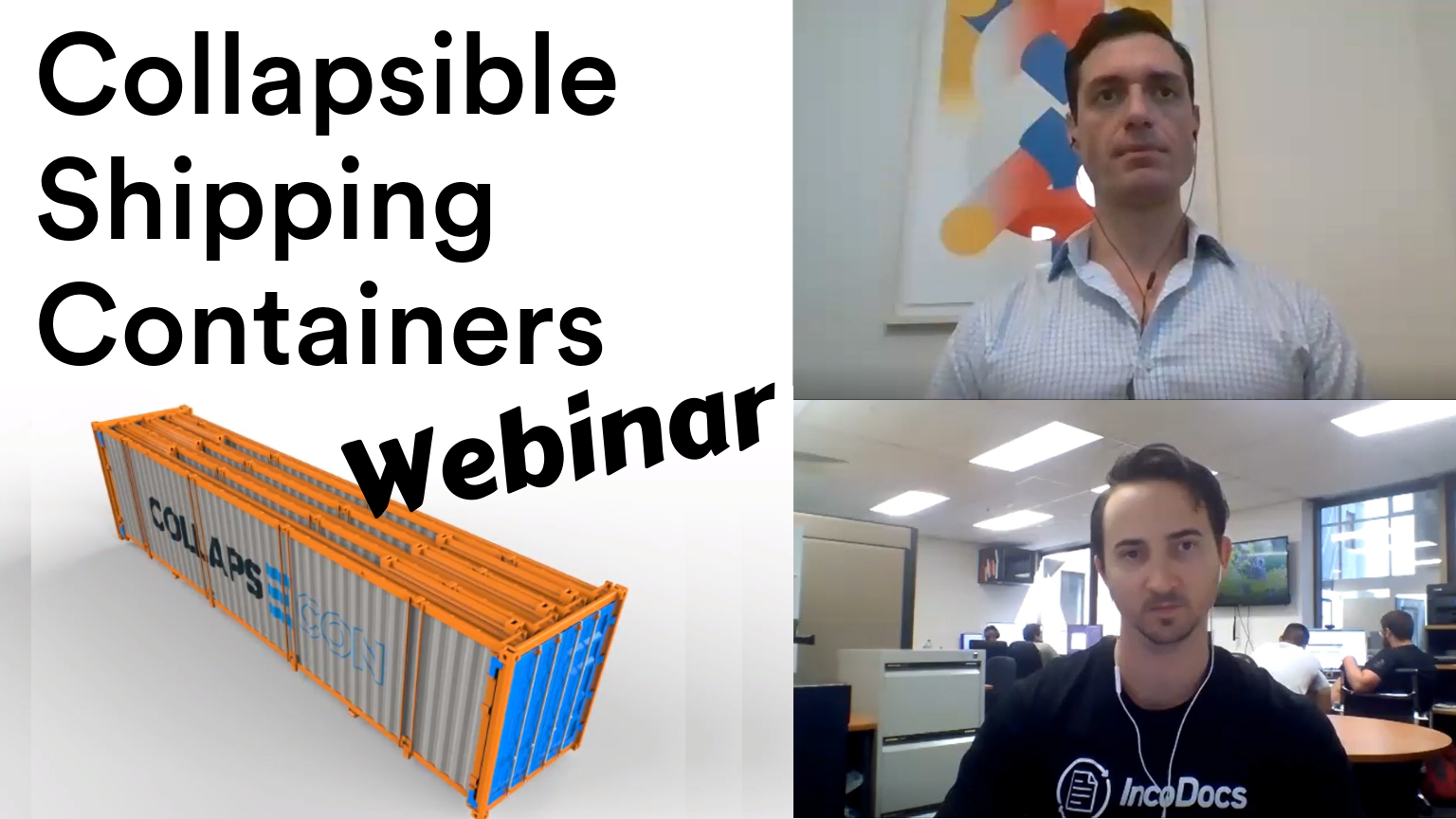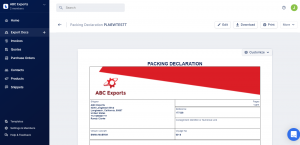The Import Export Podcast
Nicholas from CEC Systems discusses how collapsible shipping containers can be used throughout the supply chain. We discuss the logistics issues throughout the supply chain that will be solved through reliable collapsible containers.

Imbalanced supply supply chains results in re-positioning empty shipping containers around the world. This lead to Nicholas and his team at CEC systems to design and engineer a collapsible shipping container that is strong, reliable, easy to use. On top of that, they can be handled and stacked just like any other shipping container. The containers are available in the market now and will continue to provide better solutions for multi-modal transport.
Topics Covered:
- How Nicholas’ experience in transporting equipment for the Australian Army revealed the extent of the problem
- The issues that are faced along the supply chain today that can be solved with reliable collapsible shipping containers
- Which modes of transport will benefit from this design
- Collapsible shipping containers have been tried before, yet they haven’t had huge market penetration. We explore the downfalls of some other designs and how is CEC systems ensured that they built a better design
- Are the containers being used in the market now? What is the market reaction to a collapsible shipping container?
Listen to Podcast:
Watch Webinar
Are you working on innovative solutions for the Supply Chain? Contact us for Media partnership opportunities.
Contact UsRead full interview here:
Ben: 00:05
Hi, everybody. It’s Ben Thompson here. Welcome to the Import/Export Podcast. Today, we’re talking about collapsible shipping containers. We all know that the 20-foot and 40-foot shipping containers have changed the way that global trade and products are being shipped all around the world.
Since the beginning of the shipping container in the late 50’s, it has absolutely changed the way goods are traded. Today, we’re joined by Nicholas from CEC Systems to discuss his collapsible shipping container design and how it fits into the market.Nick, welcome to the show.
Nicholas: 00:37
Thanks for having me. I appreciate being here.
Ben: 00:40
Before we get started, Nicholas, tell me a bit about the experience you’ve had in logistics and how you actually came to developing collapsible shipping container.
Nicholas: 00:49
Sure. I started my career as a young 18-year-old joining the Australian Army. After 18 months had gone through, I graduated and I was actually placed into the Royal Australian Corps of Transport. Now, I ended up specializing in more of the international strategic multi mode pool type logistics where we looked at planning of how we deploy and redeploy battlegroups. That was actually where this whole thing came from.
In 2008, I was deployed to Kuwait and then to Afghanistan in that specific strategic logistics role, and one of the things that we noticed was the amount of the equipment coming into Afghanistan to support all the troops in country. Now, the reality was that everything had to come in by either air, which was really expensive, or it came in by shipping containers from Karachi up through the mountains into Afghanistan.
What the issue we noted was all these troops in country– I think at that time there was about 100 thousand troops in the country. So, a quite significant amount of troops. With that many troops comes a lot of equipment. So, the containers would come in but then they would be unloaded in Kandahar or various other places. Then, that equipment would then filter out to the wider operations, bu tthe container itself, because it cost to bring the container up from Karachi into Afghanistan was $12,000 US per box, basically it was structured that the cost to return them was far greater than the actual value of the box. So, they all ended up just sitting there because it was cheaper to leave them there and write them off.
So, the companies that had these contracts were smart. They would go around their fleets and dig up the old boxes that were on their last legs and they knew that they would not be coming back. Then, they charge Defence for a whole new one. It was just a purely economic question of whether these boxes would be returning. Seeing these boxes are piling up, and at one point, we had something like 15,000 boxes at one of the bases, there’s only so much you can do with those boxes. You can convert them into workshops and things like that or bunkers or whatever, but you get through 500 and you’re still sitting there going, “Well, there’s another 14,000 to go.”
I started looking at them and said, “Hang on. If this is a problem in a military context, what is the problem in a civilian context?” I like to look at history and I like to see, “Okay, well, a lot of great technology has come from the military.” The first box itself, the 20-foot box, really came into its own during the Vietnam War. I like to look at the military examples that gave us this technology here from a military perspective, what is the commercial or the civilian implications of this?
It was from there that I started researching and understanding, “Well, this is a global problem, this is a30-billion dollar a year loss problem.” There’s got to be a solution in which you can’t necessarily remove the problem because it’s an imbalanced problem, but maybe you can reduce the impact. That’s why I started thinking about,”What about an idea of the box that collapses?” It happened with pallets. It happens with storage company. It happens with all kinds of things. Why shouldn’t or couldn’t a container collapse? That’s the genesis of where this came from an effort for me, at least, where this came from and how it was influenced by an operational setting.
Ben: 4:25
That’s very interesting. It’s obviously a massive problem with your military background. It’s obviously a problem as well in civilian life or commercial life, commercial shipping. When you looked into the market, when you’re talking about commercial shipping, can you give me some examples of what types or what routes or what scenarios that straightaway a collapsible shipping container would be a lot better solution?
Nicholas: 4:55
Sure. I openly say that a collapsible solution is not meant to replace every container in the world. There’s a lot of countries, a lot of trade routes where “one container in, one container out.” They work the load. Particularly, let’s say, in a European context where trade is moving all around Europe by rail and you can load the container and unload it at one end and then there’s enough cargo to load it back up and you can ship it direct.
Where collapsibles come in is traditionally around major trade advanced routes. If we look at the big shipping lines and stay in a country to country route, China to Australia, for example. We know that Australia, we don’t export that much consumable goods or produced good. We export a lot of fruit and vegetable. We export a lot of natural minerals and resources, iron or coal, all that stuff, but we don’t build consumer-based products like TV’s and things like that. Let’s say China, for example, they import a lot of our coal and that sort of things but they export a lot of consumer-based products: clothing, electronics,all that thing.
So, you can already see that on a route like this, there is a major imbalance between what is imported and what is exported. Therefore, the use of a container on that route is still very valid, but it results in basically a stockpiling of empties at one end. On that Australia-China route, because of the trade imbalance, because of the imbalance in what we import and export on both ends, basically for every 100 containers that come into Australia, our export capacity is only 35 containers. So, that means out of every 100 you have 65 accumulating in Australia that eventually have to be shipped back up North for reselling because they incur their own costs being it be sitting in Australia. They also represent an asset on the owners books. It’s an asset that they want to be able to reuse.
Ben: 6:48
That’s right.
Nicholas: 6:51
The problem is magnified when you go to smaller countries and regional shipping lines and routes. If we looked at, say, Australia and other Pacific Islands, we export food and things like that to the Pacific Islands, the imbalances is almost for every 100 containers that we export, our import there is only one back. Basically, 99 containers come back to us empty or go on somewhere else empty because those countries don’t produce enough export to fill those containers.
The same problem is replicated when you look at regional routes, places like Indonesia and Philippines where your domestic supply is actually through regional shipping lines because you’re island-base nation. Australia is lucky to have rails, so you can put everything on rail and rail it around the country; but let’s say Indonesia or Philippines, they are island country so things have to move through coastal shipping, through regional coastal shipping. That same problem exists but at a regional look, because you have parts of the country that will consume and parts the country that will produce. It’s these routes where the empty container forms the biggest problem and it’s these routes where the collapsible container actually, again, can’t solve the problem but can dramatically reduce the loss associated with the storage and redistribution of those containers on those routes.
Ben: 8:10
Interesting. Absolutely. Everybody’s losing money when containers are being moved around empty. And as you say, if it’s such a trade imbalance. In that example, one container returning full as to 100 that have been sent there. That’s obviously costing a lot of money. Along other modes of the supply chains, those are examples within sea. I assume that these problems will exist the same along rail and road transport potentially as well. Where will it be adopted, in which area the most, will it be only sea freight or be a mixture of lots of those modes? What do you think is going to happen there?
Nicholas: 8:56
I think it’s both class and more dependent on where it’s going to be most effective across the industry as a wider industry. Why I say that is when we look at the three main uses/owners of the containers across the supply chain, you have the sea, you have the rail, and you have the road.
The break-up is essentially the major shipping lines and the container leases will own the majority of the container fleet. But then, you will have 3PL’s who own a percentage of containers. So you may have, say, a domestic 3PL operator who may have 40,000 containers versus Maersk who may have 3.2 million containers, but they do have a fleet. Why I say it’s a different asset class it depends on which you’re talking to. If you’re talking to a major shipping line, 60% of their fleet at a minimum is 40-footers and then about 80% is 20-footers, and then the rest are reefers and all kinds of other bits and pieces.
A 45-foot is for domestic US operations, things like that. So, they have a bit of a mix. But 40-footers make up their main type. When you look at, say, the regional shipping lines who particularly focus on coastal domestic shipping, double their 20-footers because 20-footers for them are easier to move domestically when they go then to the next mode being the road, because obviously the 20-footers are easy to maneuver out city versus a 40-footer. They have a different climate based on the mode of transport they’re traveling on. Then, to add to that, there’s also the route side to this which is when you look at, say, the shipping lines, they’ll want the 40-footers on the major route.
When you look at the coastal shipping lines, they’ll want the 20-footers on the domestic/coastal routes; but when you look at the 3PL’s, they’ll want the 20-footers to the road but then they’ll want the 40-footers to the rail. So, Sydney to Perth is a really good example because the cost is prohibitive to send a ship from Sydney and Melbourne all the way around to Perth before going back up into Asia. Most of the time, not all, but most of the time, cargo destined for Perth in Western Australia ends up being offloaded in Sydney and Melbourne and then railed across to Perth because it’s actually cheaper to do that.
Those containers, when they get to Perth, again, Perth is a commodity-based export not a product-based export, so those containers end up going back to Sydney or Melbourne by rail empty. They want 40-footers because a 40-footer is doubling capacity with half the handling of 20, basically. It’s the same handling as the 20, I should say. It’s just 20 is 20. So, as I said, the use or the selection to use collapsible containers is very much depending on the mode that you’re using and the route that you’re using. As I said at the start, it is definitely not designed to replace all containers. It’s designed for imbalanced routes where the imbalance is significant and will only grow over time as trade grows.
Ben: 12:01
That sounds like there’s definitely a lot of opportunity there that’s just being wasted. There’s plenty of examples in the market where it can be used and that it should bring a lot of cost savings in many different areas around the world. So, I think it’s only a great thing.
Tell me a bit about the design of your shipping containers. In the past, there’s been a few designs of collapsible shipping containers and it never seemed to become a mainstream product. Why do you think–what’s the flaws of some of the previous designs and what is your team doing to ensure that your collapsible shipping container is quite strong and will be reliable?
Nicholas: 12:45
Absolutely right, there have been other attempts at collapsible shipping containers in the past, going back at least 25 if not 30 years. What we did when we looked at this, as I said at the beginning, this was driven around in an operational requirement. I’m not an engineer by trade, I’m a logistician. When I looked at the product, I looked at it from an operational perspective not an engineering perspective. I worked through as products specs and said, “This is what from an operational point of view it has to achieve” and then we could figure out the engineering of how we make that happen versus what is an engineering solution that work perfectly regardless of the operational requirements. That has been one of the big issues.
The big issues have been that– essentially, it’s got to do with operational cost and safety. They could mean the three big barriers to collapsibles in the past. Almost all the collapsibles that have been developed have essentially been somewhat flatrack type design, essentially a container that collapses to a third or a fourth of its height and then you just stack them one two three and four as a flat-pack. I looked at that and said, “Well, there’s a natural limitation from an operational point of view of their capacity to sustain weight on top of their unit.”
So, what we looked at in our design was we started off with the idea that every container has to have a big end frame at each end that can sustain weight. What we did in our one was essentially created a container that could be treated like a standard unit whether it’s in a single state or a combined state. So, these big end frames that we’ve developed can actually take 382 ton on top of them, which means if you’ve got a stack of 10 fully laden containers, you can put that at the bottom of the vessel or the bottom of the stack at the port and you can treat it like a normal container. You’re not having to add operational process and thinking to how you handle this container from a day to day planning point of view. That’s one part.
Another part has been around from an operational point of view. Being collapsible brings a requirement to actually collapse or expand the container. That takes time and that’s a service that cost money. That’s been a natural limitation. What we said was one of the reasons why that’s a natural limitation is the time it takes and the delay in, basically, the poor or empty container park operations in having to collapse these things. Because the handling was excessive where you would need a crane or a forklift or whatever to actually be involved in the collapsing. Then, once it was collapsed, and let’s say it’s a quarter of it’s height, has to then be stacked and then stacked and then stacked, and then they have to be moved as separate units still. So, yes, okay you saved in storage but you didn’t necessarily save in handling. If anything, you actually increased your handling requirement.
We said, “No, we’ve got to address that straight on.” We designed a platform that goes with our container, that allows you to collapse the container in about two minutes or less. Our best time we ever did it was 55 seconds to collapse a container. Especially, it meant that the platform enabled a forklift to drive the container, dump it on the platform, drive away, and get the next one. Whilst the operators were then collapsing it in two minutes or less, you could then simply bring the next container and fix it right next to it. Then, once you’ve done that with the four containers and they ended up forming like a toaster, essentially the end frames we mentioned form the method of interlock. That resolved a number of things around how much handling intensity was involved to collapse. Again, that was one of the big issues of why they haven’t been widely uptake across the industry.
Another side has got to do with the safety, which has always been around the operators getting in and out of these containers collapsing. Now, personally, I don’t like the idea of getting into a 40-foot bit of steel that’s collapsing. We’ve addressed that by having a complete stand-back system where you can stand back and press a button, then essentially it collapses.
Then,finally, the cost. The biggest issue like anything is always the cost of the system. Look, I’ll be honest to say our systems are more expensive than a standard box. Of course, they’re going to be. They’re more complicated and they actually use more steel. But the reality is that the cost issue has always been associated with the fact that there has never been a significant mass quantity of collapsibles in the market to be able to get an economy of scale in production. We have been… …very specific about how we manufacture the container. We utilize common industry standard material, common industry standard manufacturing processes, common industry standard manufacturing in general. That has enabled us to get the cost down to still a higher point of a normal container, but a more reasonable point of acquisition. Upfront, based on the return on investment is going to generate over the life.
These are traditionally the issues that are being presented and these are the issues that we have worked to overcome with our design. As I said about the design, it’s essential you looked at it and said, “It’s got to stay up, it’s not a flatpack, it’s actually a whip to collapse.”
Ben: 17:58
That sounds great, Nicholas. You’ve obviously put a lot of time and effort into understanding what the problems were with collapsible shipping containers in the past and made sure that you’ve overcome those. Like you said, straight away the biggest issue these containers have got is to be able to be stacked and moved around and be able to be placed anywhere in a stack at a port or a railhead or whatever, and they’ve got to be handled the right way, they’ve got to be easily taken apart and put back together. It sounds like you guys have really come up with a really unique solution here. I hope it takes off well for you guys.
Nicholas: 18:42
Well, thank you. The reality, as I said earlier in the interview, is this system has really been the design has been driven by both an understanding of what’s come before and an operational perspective. It’s amazing when we would go and see many of the shipping lines, many times they’ll take a meeting out of respect and say, “Okay, look, we will meet with you.” We generally get the same response at the beginning of each meeting which is,”Collapsibles, we’ve seen this before.”
It’s amazing to watch their face, their attitude, their whole demeanor change when we show them the system because their perception of what they think we’re going to present versus what we have to develop is vastly different. They often think it’s flat pack. They often think the biggest issue is strength, as we just said then. We spent so much time understanding the specification and understanding the history and then building the specification based on your operational requirement that we are getting very different responses.
The fact that we collapse from a width perspective instead of a height perspective automatically, in many minds, changes their perception. The fact that, for example, we have a steel floor and that enables us to load the container with all the weight like normal container with the forklift driving in and out and all that thing. Again, these designs from the operational perspective has meant that the industry looks at us and says, “This is actually something very different that we haven’t seen before, we’re willing to talk further about this.” It’s a great feedback to receive.
Ben: 20:22
Yes. Absolutely. What stage are you at within the market? You’ve built these units. Have you got them out there doing trials? When will you be able to do these in mass production?
Nicholas: 20:38
Essentially, we are already set up for mass production. We spent the last couple of years building. The product itself Collapsecon is the product. But we had originally developed what we call the C400, the cargo 40-foot version zero. It was built as a proof-of-concept system because, obviously, this is a radically new design that still have to achieve all the things. Be treated like a normal container, look like a normal container, but yet collapsed to a quarter of its width and then combined together with no external part.
These are some key things that we have to solve through the proof-of-concept. When we did that, we actually over-engineered the system. We did that intentionally. It was very heavy. It had a lot of extra steel that it didn’t need to do, because we designed it not only to the CEC standard but to the ISO standard and the American railroads standard and a whole bunch of different standards. So, as the result of that, it was very over-engineered. Through our support from the Australian Government and the Singapore government, we have essentially spent the last year and a half optimizing the system dramatically. That looked at how do we produce it cheaper, how do we use less steel, how do we increase the load capacity, how do we make it even more operationally functional, all these things.
That has resulted in the development of the C401. The 401 is actually the commercial version of the system. That product is actually now ready and that product will start trials with a number of shipping lines and 3PL’s throughout the year. Basically, as a business, the way we operate is we have a small trial fleet of containers that we own, and we provide them to customers for a period of two, three, or four months depending on what nature of the trial is, whether it’s road, or city, or rail, or whatever it might be. Then, from there we work with those customers to actually show the benefit of the system in their supply chain.
As I said, it’s meant for specific routes, not all routes. That product will actually be out with the customers throughout all of 2019. Then, from there, basically, how we operate is that we don’t hold actually a fleet. We don’t build a fleet and then hold them really as inventory itself. We actually build to order. From there, once the customers are happy then they can choose to either buy containers or lease containers or however they want to engage. The 401 is now available for market as well as a tracking system that we have to make sure that the users can get best optimization of where are my containers at any one time.
So, I have my plan for my quarter 1. Then, later in the year, through customer demand, we’ve actually accelerated the development of our 20-footer. That will hopefully be ready for the market release by the end of the year as well. We’ve had quite a few customers say, “Look we love the 40. We want to engage with the 40, but we also want the 20. When can you get it to us as well?”
That’s accelerated our timeline quite a lot, which is a great problem to have. The 401 is available for trials from this year as it’s already going out for trials this year with customers.
Ben: 23:39
Absolutely, that sounds great. How can interested potential customers get in touch with you? What’s the best way to get in touch about new sales inquiries?
Nicholas: 23:48
I would say head over to our website, www.cecsystems.com and there’s an inquiry element that they can leave their interest in. Then, we will happily collect them.
Ben: 24:01
Alright. That’s great. Thanks, Nicholas, for giving us an insight into your collapsible container. It’s very interesting in how many used cases this type of container can be applied to straightaway. I’m excited to see how far it penetrates into the market and how long it takes to get mass reach. I think, it’s not too far off. The world of shipping is changing and I think it’s going to happen quicker than we think.
Nicholas: 24:38
We’re hoping.
Ben: 24:41
Thank you very much, Nicholas, for your time. We’ll leave with that.
Nicholas: 24:45
Thank you for having me. I appreciate it.







